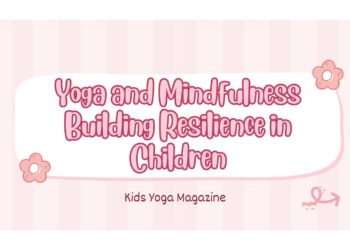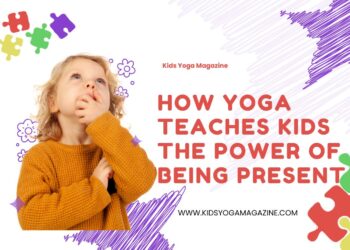In a world where children are constantly bombarded with distractions and pressures, teaching mindfulness can be a powerful way to help them develop focus, emotional resilience, and a sense of inner calm. One of the most effective and engaging ways to introduce mindfulness to kids is through yoga. Combining physical movement with mindful awareness, yoga offers a fun and accessible approach to helping children cultivate mindfulness in their everyday lives. Here’s how you can teach mindfulness to kids through yoga, fostering both their physical and mental well-being.
1. Start with Simple Breathing Exercises
Breathing is a fundamental aspect of both yoga and mindfulness. Teaching kids to focus on their breath is an excellent way to introduce them to the concept of mindfulness. Simple breathing exercises help children become aware of their breath and its connection to their body and mind.
- Balloon Breathing: Have your child imagine their belly is a balloon. Ask them to place their hands on their belly and take a deep breath in through the nose, filling the “balloon” with air. As they exhale slowly through the mouth, they can imagine the balloon deflating. This exercise teaches kids to focus on the rise and fall of their breath, grounding them in the present moment.
- Feather Breathing: Give your child a lightweight feather or a small piece of tissue paper. Ask them to lie down or sit comfortably with the feather resting on their belly. As they breathe in and out, they can watch the feather rise and fall. This visual aid helps children connect with their breath, making mindfulness more tangible and engaging.
2. Incorporate Mindful Movement Through Yoga Poses
Yoga poses offer a great way to introduce mindful movement to children. Each pose encourages them to focus on their body, their breath, and the sensations they experience in the moment. Start with simple, child-friendly poses that are easy to learn and practice.
- Mountain Pose (Tadasana): Begin with this foundational pose that teaches kids about stillness and grounding. Have your child stand tall with their feet together, arms by their sides, and eyes closed. Encourage them to notice how their feet feel on the ground, how their body stands tall, and how their breath moves in and out. This pose helps children develop awareness of their posture and breath, bringing their attention to the present moment.
- Tree Pose (Vrksasana): Tree Pose is a balancing pose that helps children develop focus and concentration. Ask your child to stand on one leg and place the sole of the other foot on the inner thigh or calf of the standing leg (avoid the knee). Encourage them to focus on a point in front of them to maintain balance. This pose teaches children to concentrate and be mindful of their body’s movements and stability.
- Cat-Cow Pose (Marjaryasana-Bitilasana): This gentle flow between Cat Pose and Cow Pose encourages children to connect their breath with movement. Have them start on all fours and then arch their back (Cow Pose) as they inhale, and round their spine (Cat Pose) as they exhale. This flowing movement helps children become aware of the connection between breath and body, making it a perfect introduction to mindful movement.
3. Introduce Mindfulness Through Visualization
Visualization is a powerful mindfulness tool that can help children focus their minds and calm their emotions. Guided visualizations can be incorporated into a yoga practice to enhance relaxation and mental clarity.
- Rainbow Visualization: After a yoga session, have your child lie down in Savasana (Corpse Pose) with their eyes closed. Guide them through a rainbow visualization, asking them to imagine a big, colorful rainbow in the sky. As they breathe in, they can imagine they are inhaling the colors of the rainbow, and as they breathe out, they can imagine spreading those colors out into the world. This visualization promotes calmness and helps children focus their minds.
- Peaceful Place Visualization: Ask your child to imagine their favorite peaceful place—this could be a beach, a forest, or even their own room. Guide them to visualize all the details of this place, using their senses to feel, see, hear, and smell their surroundings. This visualization helps children create a mental refuge they can return to whenever they need to calm down or find peace.
4. Practice Mindful Games and Activities
Mindful games and activities can make mindfulness more engaging and fun for kids. These activities can be seamlessly integrated into a yoga session or practiced on their own.
- Yoga Freeze Dance: Play some calming music and let your child dance freely. When the music stops, have them freeze in a yoga pose. Encourage them to focus on maintaining the pose and being still. This game not only makes yoga fun but also teaches mindfulness through the practice of focusing on the present moment.
- Mindful Listening: During a yoga session, take a moment to practice mindful listening. Ask your child to close their eyes and listen to the sounds around them for one minute. Afterward, discuss what they heard—whether it was the sound of their breath, the rustling of leaves, or distant traffic. This activity helps children develop awareness of their environment and enhances their ability to focus.
- Gratitude Yoga: At the end of a yoga session, have your child think of something they are grateful for while holding a simple pose, like Child’s Pose or Easy Pose. Ask them to focus on their breath and the feeling of gratitude. This practice combines mindfulness with positive thinking, helping children cultivate a grateful and mindful mindset.
5. Create a Regular Mindfulness Routine
Consistency is key when it comes to teaching mindfulness to kids. Establish a regular mindfulness routine that includes yoga and other mindful practices. This routine could be a short morning yoga session to start the day with focus or a calming evening practice before bed.
You can also incorporate mindfulness into daily activities, such as mindful eating, where your child pays attention to the taste, texture, and smell of their food, or mindful walking, where they focus on the sensation of their feet touching the ground. By integrating mindfulness into everyday moments, children learn to bring awareness and presence into all aspects of their lives.
Conclusion
Teaching mindfulness to kids through yoga is a powerful way to help them develop focus, emotional resilience, and a sense of inner calm. By introducing simple breathing exercises, mindful movement, engaging games, and visualization techniques, you can make mindfulness accessible and enjoyable for children. As they practice these techniques, they’ll not only improve their physical health but also enhance their emotional well-being. With regular practice, mindfulness becomes a natural part of their daily routine, providing lifelong benefits for their overall well-being.












